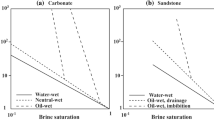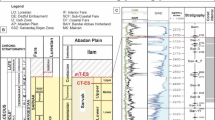Abstract
Vuggy reservoirs are the most common, albeit important heterogeneous carbonate reservoirs in China. However, saturation calculations using logging data are not well developed, whereas Archie method is more common. In this study, electrical conduction in a vuggy reservoir is theoretically analyzed to establish a new saturation equation for vuggy reservoirs. We found that vugs have a greater effect on saturation than resistivity, which causes inflection in the rock-electricity curve. Using single-variable experiments, we evaluated the effects of vug size, vug number, and vug distribution on the rock-electricity relation. Based on the general saturation model, a saturation equation for vuggy reservoirs is derived, and the physical significance of the equation parameters is discussed based on the seepage-electricity similarity. The equation parameters depend on the pore structure, and vugs and matrix pore size distribution. Furthermore, a method for calculating the equation parameters is proposed, which uses nuclear magnetic resonance (NMR) data to calculate the capillary pressure curve. Field application of the proposed equation and parameter derivation method shows good match between calculated and experimental results, with an average absolute error of 5.8%.
Similar content being viewed by others
References
Aguilera, M. S., and Aguilera, R., 2003, Improved models for petrophysical analysis of dual porosity reservoirs: Petrophysics, 44(1), 21–35.
Aguilera, R., 1976, Analysis of naturally fractured reservoirs from conventional well logs: Journal of Petroleum Technology, 28(7), 764–772.
Aguilera, R. F., and Aguilera, R., 2004, A triple porosity model for petrophysical analysis of naturally reservoirs: Petrophysics, 45(2), 157–166.
Alger, R. P., and Raymer, L. L., 1963, Formation density log application in liquid-filled holes: JPT, 15(4), 321–332.
Archie, G. E., 1942, The electrical resistivity log as an aid in determining some reservoir characteristics: Trans. AIME, 146, 54–62.
Berg, C. R., 1995, A simple, effective-medium model for water saturation in porous rocks: Geophysics, 60(4), 1070–1080.
Berg, C. R., 1996, Effective-medium resistivity models for calculation water saturation in porous rock: The Log Analyst, 37(3), 16–28.
Brooks, R. H., and Corey, A. T., 1966, Properties of porous media affecting fluid flow: J. Irrig. Drain. Div., 6, 61.
Clavier, C., Coates, G., and Dumanoir, J., 1984, Theoretical and experimental bases for the dual-water model for interpretation of shaly sands: SPE Journal, 24(2), 153–168.
Dewitte, L., 1950, Relation between resistivities and fluid content of porous rock: J. Oil and Gas, 49(8), 120–132.
Dewitte, L., 1955, A study of electric log interpretation methods in shaly formation: AIME, 204, 103–132.
Fraser, D., 1958, A quantitative study of electric logs in oil-wet and fractured reservoirs: Ph.D. dissertation, The University of Texas.
Kazatchenko, E., Markov, M., and Mousatov, A., 2004, Joint inversion of acoustic and resistivity data for carbonate microstructure evaluation: Petrophysics, 45(2), 130–140.
Kazatchenko, E., Markov, M., and Mousatov, A., 2004, Joint modeling of acoustic velocities and electrical conductivity from unified microstructure of rocks: Journal of Geophysical Research: Solid Earth, 109(B1), 8.
Kazatchenko, E., Markov, M., and Mousatov, A. et al., 2006, Simulation of the electrical resistivity of dualporosity carbonate formations saturated with fluid mixtures: Petrophysics, 47(1), 23–36.
Li, N., 1989, General forms of the resistivity-porosity and resistivity-oil/gas saturation relations, as well as the determination of their optimum approximating function types (I): Chinese geophysics Journal (in Chinese), 32(5), 580–591.
Li, N., 1993, General forms of the resistivity-porosity and resistivity-oil/gas saturation relations, as well as the determination of their optimum approximating function types (II), Society of Exploration Geophysicists (in Chinese), Chinese Petroleum Society, Beijing, 239–242.
Mao, Z. Q., and Gao, C. Q., 2000, Theoretical simulation of the resistivity and pore structure of hydrocarbon bearing rocks: Petroleum Exploration and Development (in Chinese), 27(2), 87–90.
Pan, X. F., Zeng, W., and Zhang, Z. et al., 2006, The microscopic characteristic and meanings of fractured reservoir in Qing-Xi area: Journal of Southwest Petroleum Institute (in Chinese), 28(5), 36–39.
Poupon, A., Loy, M. E., and Tixer, M. P., 1954, A contribution to electric log interpretation in shaly sands: AIME, 201, 138–145.
Purcell, W. R., 1949, Capillary pressures-their measurement using mercury and the calculation of permeability: Journal of Petroleum Technology, 1(2), 39–48.
Silva, P. L., and Bassiouni, Z., 1986, Statistical evaluation of the S-B conductivity model for water-bearing shaly formation: The Log Analyst, 27(3), 9–19.
Simandoux, P., 1963, Dielectric measurements of porous media: application to measurement of water saturations, study of the behavior of argillaceous formations: Revue de L’ Institut Francais du Petrole, 18(S1), 193–215.
Song, Y. J., Shi, Y., and Zhang, Q. G., 2004, On generalized resistivity model for laminated and dispersed shaly sands: Well Logging Technology (in Chinese), 28(2), 118–123.
Waxman, M. H., 1974, Electrical conductivities in shaly sands: (I) The relation between hydrocarbon saturation and resistivity index; (II) The temperature coefficient of electrical conductivity: Journal of Petroleum Technology, 26(3), 213–225.
Waxman, M. H., and Smits, L. J. M., 1968, Electrical conductivities in oil-bearing shaly sands: SPE 1863-A, SPE 42nd Annual Fall Meeting, Houston, Tex., Oct. 1–4, 1967.
Zhao, L. X., and Bu, Y., 1994, Well logging evaluation technology of carbonate reservoir: China Petroleum Industry Press, 90–97.
Author information
Authors and Affiliations
Additional information
This work was supported by the National S&T Major Special Project (No. 2011ZX05020-008).
Sun Wen-Jie, graduated from China University of Petroleum (East China) in 2008 with a major in Petroleum Engineering. She is currently a Ph.D student in Peking University and the Research Institute of Petroleum Exploration and Development (RIPED), CNPC. Her research focuses on Experimental Rock Physics.
Rights and permissions
About this article
Cite this article
Sun, WJ., Li, N., Wu, HL. et al. Establishment and application of logging saturation interpretation equation in vuggy reservoirs. Appl. Geophys. 11, 257–268 (2014). https://doi.org/10.1007/s11770-014-0438-0
Received:
Revised:
Published:
Issue Date:
DOI: https://doi.org/10.1007/s11770-014-0438-0




